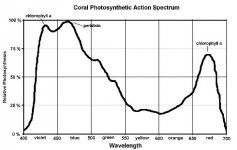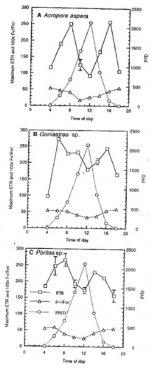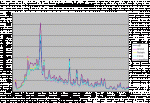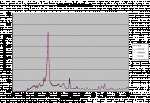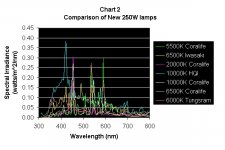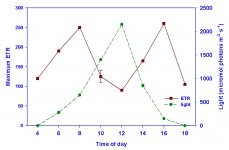My $0.02 (again  )...
)...
The Dana Riddle study on the previous page basically showed that photosynthetic activity in corals was independent of spectral quality and a function of overall intensity.
I've yet to see in this thread, or anywhere, a similar study that shows a monochromatic blue lamp outperforming a wider spectrum lamp of equivalent PAR. I'm not saying it couldn't happen - I've just never seen the study.
Of course another one of his studies showed that spectrum had a very pronounced effect on coral coloration. It also showed that, if isolated, certain spectrums are probably more important to photosynthesis. He also mentioned that corals can utilize wavelengths outside that optimum range for photosynthesis, which (to me anyway) is what complicates this whole thing...
So in other words - according to Dana's work, if you had a 250 watt 6500K Iwasaki lamp (high PAR) over the same corals, at the same height, in a similar reflector as 250 watt 20000K Radium (predominantly 450 nm wavelength output) you should see faster growth under the Iwasaki and better colors under the Radium.
This is exactly what many (but apparently not all ) hobbyists that have tried these lamps appear to report for results (at least in the context of SPS corals). This is also the rationale (in recent years) for combining lighting types - to get the best of both worlds.
) hobbyists that have tried these lamps appear to report for results (at least in the context of SPS corals). This is also the rationale (in recent years) for combining lighting types - to get the best of both worlds.
Of course a lot of people get the PAR they need for good growth with the 20000K lamps by going up to high enough wattage and/or getting the corals close enough to the lamps and, again, basically get the best of both worlds.
The Dana Riddle study on the previous page basically showed that photosynthetic activity in corals was independent of spectral quality and a function of overall intensity.
I've yet to see in this thread, or anywhere, a similar study that shows a monochromatic blue lamp outperforming a wider spectrum lamp of equivalent PAR. I'm not saying it couldn't happen - I've just never seen the study.
Of course another one of his studies showed that spectrum had a very pronounced effect on coral coloration. It also showed that, if isolated, certain spectrums are probably more important to photosynthesis. He also mentioned that corals can utilize wavelengths outside that optimum range for photosynthesis, which (to me anyway) is what complicates this whole thing...
So in other words - according to Dana's work, if you had a 250 watt 6500K Iwasaki lamp (high PAR) over the same corals, at the same height, in a similar reflector as 250 watt 20000K Radium (predominantly 450 nm wavelength output) you should see faster growth under the Iwasaki and better colors under the Radium.
This is exactly what many (but apparently not all
Of course a lot of people get the PAR they need for good growth with the 20000K lamps by going up to high enough wattage and/or getting the corals close enough to the lamps and, again, basically get the best of both worlds.




